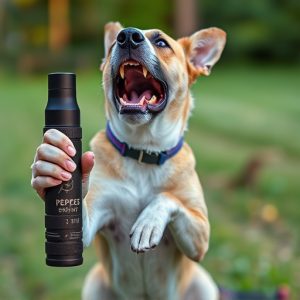Mastering Dog Attack Pepper Spray: Legal Guidelines and Safe Usage
Dog attack pepper spray is a specialized tool for stopping aggressive dogs quickly, targeting their…….
Dog attack pepper spray is a specialized tool for stopping aggressive dogs quickly, targeting their eyes and nostrils. US states have varying regulations regarding its possession and use, with some allowing it without a permit (e.g., Texas, Florida) while others require permits or licenses (e.g., California). Understanding these Pepper Spray Dog Laws by State is crucial for responsible use. Proper application involves aiming at the dog's face from 2-3 feet away as a last resort to de-escalate dangerous situations. Users must adhere to local laws, store pepper spray safely, and train properly to avoid legal consequences and ensure its effectiveness during attacks.
In many states, pepper spray is emerging as a vital tool for self-defense against aggressive dogs. Understanding dog attack pepper spray—its composition, effectiveness, and safety protocols—is crucial for responsible ownership. This comprehensive guide delves into the mechanics of this potent weapon, exploring state-by-state pepper spray dog laws, optimal usage scenarios, legal considerations, and best practices for carrying this game-changer. By armed with knowledge, you can navigate this dynamic landscape effectively and ensure your safety in various settings.
- Understanding Dog Attack Pepper Spray: What It Is and How It Works
- Pepper Spray Dog Laws by State: A Comprehensive Overview
- When and How to Use Dog Attack Pepper Spray Safely
- Legal Considerations and Responsibilities for Pepper Spray Use Against Dogs
- Best Practices and Precautions for Owning and Carrying Dog Attack Pepper Spray
Understanding Dog Attack Pepper Spray: What It Is and How It Works
Dog attack pepper spray is a specialized self-defense tool designed to stop aggressive canine encounters quickly and effectively. Unlike traditional pepper spray formulated for human confrontations, dog attack spray targets the sensitive eyes and nostrils of a barking or biting dog, temporarily disabling it and providing the user with an escape route. This type of spray is often considered as a last resort when all other de-escalation methods have failed.
The formula of dog attack pepper spray differs from standard pepper spray in its concentration and application method. It’s designed to produce a stronger, more targeted stream that can reach dogs at a distance, ensuring the user’s safety. Moreover, understanding Pepper Spray Dog Laws by State is crucial before carrying such a device. Each state has different regulations regarding the use, possession, and types of pepper spray allowed for personal protection against dog attacks.
Pepper Spray Dog Laws by State: A Comprehensive Overview
In the United States, pepper spray, particularly when used as a defense against dog attacks, is regulated at both federal and state levels. The variety and strictness of Pepper Spray Dog Laws by State differ significantly across the country, reflecting unique cultural and legal landscapes. Some states explicitly permit the use of pepper spray for self-defense against aggressive dogs while others have more stringent regulations or outright ban its civilian possession.
For instance, states like Texas and Florida allow residents to carry pepper spray for personal protection against wild animals, including dogs, without a permit. Conversely, states such as California require individuals to obtain a permit or license before purchasing and carrying pepper spray, with additional restrictions on the type and amount of oleoresin capsicum (OC) allowed. These differences underscore the importance of understanding Pepper Spray Dog Laws by State before considering the use of pepper spray for dog attack prevention.
When and How to Use Dog Attack Pepper Spray Safely
When faced with an aggressive dog, knowing how and when to deploy pepper spray can be a life-saving skill. However, it’s crucial to understand that using pepper spray on dogs is regulated by state laws, known as Pepper Spray Dog Laws by State, which vary across the US. Before considering this method of self-defense, familiarize yourself with these local regulations to ensure compliance and avoid potential legal issues.
The safe use of dog attack pepper spray involves a few key steps. First, assess the situation; if the dog shows signs of aggression but isn’t directly attacking, consider de-escalation tactics first. If danger escalates and you’re at risk of being bitten, aim for the dog’s face—specifically, its eyes and nose—from a safe distance, typically around 2–3 feet away. Act quickly but accurately to minimize spray exposure to bystanders or yourself.
Legal Considerations and Responsibilities for Pepper Spray Use Against Dogs
The use of pepper spray as a deterrent against dog attacks is a controversial topic, with legal implications varying significantly across different states in the US. While some states explicitly allow the use of pepper spray to protect individuals from aggressive dogs, others have strict regulations or outright ban its usage. Pepper Spray Dog Laws by State underscore the importance of understanding local legislation before considering this method of self-defense.
Responsibilities extend beyond merely knowing the law; individuals who choose to carry and use pepper spray must also act responsibly. This includes ensuring the spray is stored safely, out of reach of children and pets, and used only as a last resort when faced with an imminent threat from a dog. It’s crucial to familiarize oneself with local animal control policies and understand that misuse or reckless application of pepper spray could result in legal repercussions, including fines or civil litigation.
Best Practices and Precautions for Owning and Carrying Dog Attack Pepper Spray
When carrying dog attack pepper spray, it’s crucial to understand and adhere to best practices and precautions. Always ensure your state has specific laws governing the use and possession of pepper spray, as Pepper Spray Dog Laws by State vary widely. Check with local authorities to confirm legal restrictions and requirements for purchase and carry permissions.
Proper storage is paramount; keep it in a secure, child-proof location. Never leave it unattended or easily accessible. Training is equally important; familiarize yourself with the spray’s mechanics and recommended usage. Practice in controlled settings to ensure effective deployment during an actual dog attack. Remember, pepper spray is a temporary deterrent, providing valuable time for escape or assistance arrival.
In conclusion, pepper spray designed for dog attacks can be a valuable tool for personal safety when facing aggressive canines. Understanding its functionality, familiarizing yourself with state-specific regulations (Pepper Spray Dog Laws by State), and adhering to safe usage practices are paramount. By knowing when and how to deploy it responsibly, individuals can protect themselves and their loved ones from potential harm, while also considering the legal responsibilities that come with carrying such a device.

